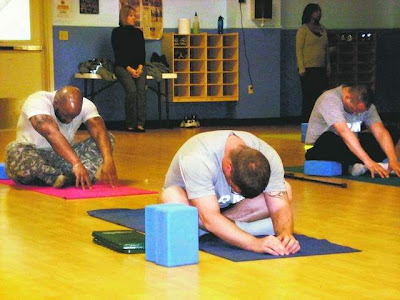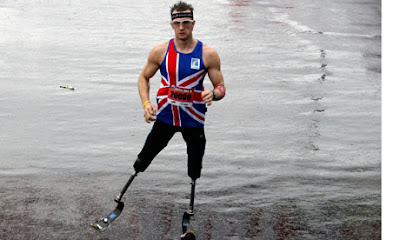 Study shows 2010 saw at least 171 troops suffer battlefield injuries resulting in amputations; 65 of them lost two limbs or more.
Study shows 2010 saw at least 171 troops suffer battlefield injuries resulting in amputations; 65 of them lost two limbs or more.Marine 1st Lt. James Byler, 25, of Long Island, New York, was leading a patrol in Afghanistan late last year when an explosion severed his legs and snapped off the ends of several fingers. He is undergoing physical therapy at Walter Reed Army Medical Center in Washington. (Carolyn Cole / Los Angeles Times / December 22, 2010)
By Tony Perry, Los Angeles Times
6:11 p.m. CDT, April 6, 2011
la-fg-afghanistan-wounds-20110407
Reporting from Landstuhl, Germany, and Helmand— Grim combat statistics that one military doctor called "unbelievable" show U.S. troops in Afghanistan suffered an unprecedented number of catastrophic injuries last year, including a tripling of amputations of more than one limb.
A study by doctors at the Landstuhl Regional Medical Center in Germany, where most wounded troops are sent before returning to the U.S., confirmed their fears: The battlefield has become increasingly brutal.
In 2009, 75 service members brought to Landstuhl had limbs amputated. Of those, 21 had lost more than one limb.
But in 2010, 171, 11% of all the casualties brought to Landstuhl, had undergone amputations, a much higher proportion than in past wars. Of the 171, 65 had lost more than one limb.
Injuries to the genital area were also on the increase. In 2009, 52 casualties were brought to Landstuhl with battlefield injuries to their genitals or urinary tract. In 2010, that number was 142.
Dr. John Holcomb, a retired Army colonel with extensive combat-medicine experience, said he and other doctors involved in the study were shocked by the findings, which he labeled as "unbelievable."
"Everybody was taken aback by the frequency of these injuries: the double amputations, the injuries to the penis and testicles," said Holcomb, now a medical professor at the University of Texas Health Science Center in Houston. "Nothing like this has been seen before."
Military brass say the increase in catastrophic injuries can be attributed to the Taliban's use of improvised explosive devices, the roadside bombs that account for the majority of U.S. and NATO deaths and injuries. Last year was also the deadliest year for U.S. troops in Afghanistan, with 499 killed, according to the Defense Department.
Troops are increasingly vulnerable to injuries from such makeshift bombs as they mount foot patrols in an effort to win support from Afghan villagers, a key strategy in the counterinsurgency campaign.
An armored Humvee provides a measure of protection from a blast. A so-called mine-resistant vehicle provides more. But when a soldier or Marine steps on a roadside bomb, there is considerably less protection from flying shrapnel or super-heated air. Also, rocks, dirt and other debris embedded in a blast wound can cause immediate and devastating infections.
The hospital at Landstuhl is the busiest it has been since the battle in the Iraqi city of Fallouja in late 2004, officials said. Both the number and severity of wounds have increased, said Air Force Lt. Col. Raymond Fang, a surgeon and trauma medical director at Landstuhl.
The average patient stays about three days at Landstuhl before being airlifted to the U.S. for further care. "All we're doing is clearing up the destruction done by the injury," Fang said.
In Afghanistan, some officers believe the insurgents have increased both the explosive power of their improvised bombs and their ability to place them for maximum carnage.
Some of the explosives are placed on fences and other aboveground locations so that the blast strikes directly at the legs of passing Marines, soldiers or medical corpsmen who accompany combat troops.
"It's a weapon of terror designed to inflict the most grievous wounds," said Marine Maj. Gen. Richard Mills, formerly the top Marine in Afghanistan.
The increase in catastrophic wounds has taken an emotional toll on the medical personnel at Landstuhl, said Navy Cmdr. Joseph Sheldon, one of nine chaplains at the U.S. military hospital.
Sheldon and the other chaplains are also present when patients awake to learn of the extent of their battlefield injuries. He remembers sitting with a wounded Marine on Christmas Eve.
"There was a lot of silence and a lot of tears, for both of us," Sheldon said. "Everybody wants their life to be the way it was, but it's not. Coming to grips with that is hard."
After the Landstuhl study was first reported in the Washington Post, Sen. Barbara Boxer (D-Calif.) asked Army Gen. David H. Petraeus, the top U.S. commander in Afghanistan, for an explanation of the increase in amputations and what the military was doing to protect front-line personnel.
The Camp Pendleton-based 3rd Battalion, 5th Regiment, has been particularly hard hit, with 24 Marines killed and more than 175 wounded while deployed in the Sangin district of Helmand province.
More than a dozen Marines from the battalion have lost two or more limbs. One of them is 1st Lt. James Byler, 25, of Long Island, New York, who was leading a patrol in early October when an explosion severed his legs and snapped off the ends of several fingers.
Byler's patrol was walking slowly, carefully, in what is called "ranger style," with each man following in the footsteps of the man in front of him.
"Everyone had gone over that spot," said Byler, now recuperating in the U.S. "I was just the one who stepped on it when it exploded.
"It wasn't a big one, but it was enough to blow my legs off."
tony.perry@latimes.com





